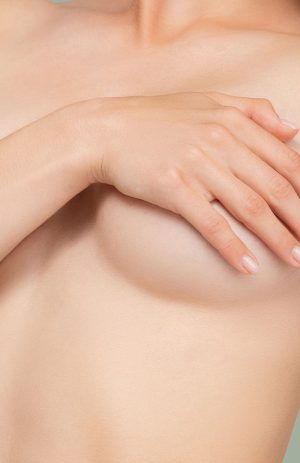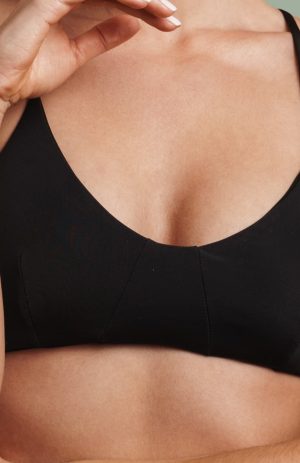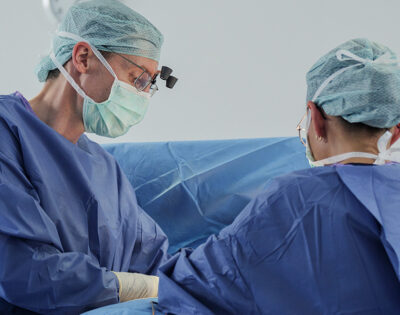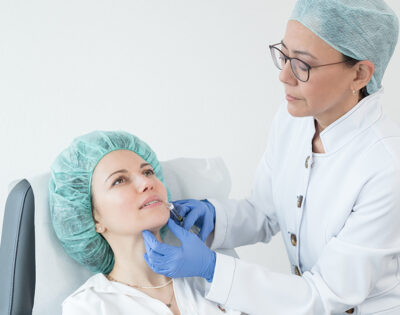Breast lift: Decide about your body
Pregnancy and breastfeeding periods, weight fluctuations and tissue changes after the menopause are considered to be the main causes of breast sagging. Many women find sagging breasts unsightly and stressful and use special support bras or a sports bra, but this only provides limited relief. Do you also feel uncomfortable with your breasts? Do you avoid looking in the mirror? Do you want a décolleté that makes you feel good again?
Feel good, always and everywhere:
- Whether in the sauna or with your partner; you will no longer feel any discomfort
- Bringing the body into balance through the right proportions
- Increasing attractiveness through breast augmentation
- Being able to do without annoying push-up bras
What our patients say
Information at a glance
Operation duration
1.5-4 hours
Aftercare
6 weeks
Anesthesia
Twilight sleep
Thread tension
Self-dissolving threads
Hospitalization
Outpatient
Socially acceptable
after 5 days
Costs
Additions or alternatives
Hybrid breast augmentation / Breast augmentation with implant

What is a breast lift?
Lifting operations, whether on the breasts or the abdomen, remove sagging, overstretched skin and fulfill the desire to give the body a youthful and attractive appearance again. The techniques have been continuously developed over many decades to achieve a natural and youthful breast shape while leaving almost invisible scars. For an optimal final result, many characteristics of the breast must be taken into account:
- The fullness and size of the breasts should harmonize with the body silhouette.
- The upper part of the breast silhouette should form a gentle, inward curve and the lower part should have a harmonious curve.
- The nipple should be at approximately the highest point of the breast. Ideally, this point should be at the height of the middle of the upper arm.
- The distance between the nipple and the inner boundary of the breast in relation to the outer boundary is ideally 60 to 40 percent 1 .
- A volume ratio of the upper and lower half of the breast of 45 to 55 percent is perceived as particularly harmonious 2 .

1 . o-technique breast lift 2 . i-technique breast lift 3. t-technique breast lift
The choice of the right technique depends on the extent of excess skin. In the case of slightly sagging breasts, a lift can be achieved using the so-called O-technique. If the breasts are noticeably sagging, they can be lifted using an I-technique or a T-technique.

1 Enlarged nipple
2 Skin to be removed
3 Skin suture
4 Enlarged areola
5 Excess skin of the areola
6 Suture with non-dissolvable sutures
7 Gathering seam

O-technique breast lift
1. slightly sagging chest.
2. marking of the excess skin.
3. tightened breast with inconspicuous scar around the areola.
Reasons for a breast lift
In addition to aesthetic reasons, there is evidence that sagging breasts promote back pain 3 . First and foremost, patients want more beautiful, firmer breasts, but breast lift surgery can also improve physical performance, self-esteem and quality of life 4 . Over 90 percent of patients are very satisfied with the results of a breast lift.

Procedure for a breast lift
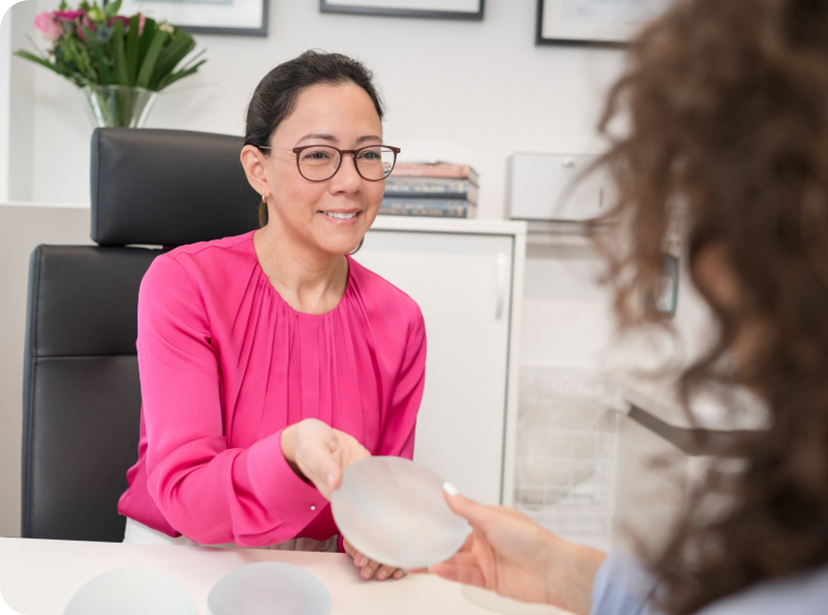
Preparation
Attentiveness and personal care ensure a pleasant atmosphere. As a preventative measure, you will be given an antibiotic before you are admitted to the operating theater. Before the start of each operation, the surgical team routinely discusses all the important points again. Only when everything has been checked will the anesthetist give you a painkiller so that you do not even feel the anesthetic injections. As a rule, the patients are already in a light sleep while the entire surgical team concentrates on the procedure.

The OP
The duration of a breast lift operation is 1.5 hours for smaller breasts and up to 4 hours for very voluminous breasts. This generally depends on the extent of the intervention. The CenterPlast practice has been using fast recovery anesthesia with great success for years. Your safety and comfort are paramount with this method. Due to the targeted long-acting anesthesia of the nerves of the chest wall, only a small amount of anesthetic is required. This form of anesthesia is considered less risky than general anesthesia. In addition, our patients recover very quickly after surgery and require less pain medication even hours after the operation.

After the procedure
Once the plastic and aesthetic procedure has been completed, a dressing will be applied. The surgical team will help you to put on the special compression bra. This special bra (also known as a support bra) must be worn for the first few weeks after the operation. If you wish, the attending physician will contact a relative immediately after the operation. You will be able to drink or eat shortly after the operation. Before you are collected, your surgeon will discuss with you again what you need to bear in mind. You will receive a letter containing all the recommendations, the follow-up appointments and the personal telephone number of your surgeon.
What methods and types of breast lift are there?
Each treatment or surgical method has specific advantages and disadvantages. The key to a perfect result is to choose the type of treatment that best suits the individual shape and size of your breasts. The recommendation of a particular technique is primarily based on the characteristics of the breasts, the mammary gland tissue and the skin. Your goals, your state of health, previous treatments and the latest scientific findings are also taken into account in order to select the most suitable breast lift method together with you. The different methods of skin tightening on the breast are classified schematically according to the course of the scar:
- O technology:
Surgical methods in which a scar remains around the areola are generally referred to as the O-technique. These methods can be used to remove a slight excess of skin with a maximum diameter of two centimeters. The technique was described as early as 1932 5 . Plastic surgeon Louis Benelli has supplemented the method with a special suturing technique around the nipple to prevent enlargement or deformation of the areola 6 . This technique is therefore often referred to as the Benelli method. However, this technique is not suitable for breast reduction. - I technology:
The term I-technique covers various methods that leave a circular scar around the nipple and a vertical scar between the nipple and the crease under the breast. Due to the shape of the scar, which mainly extends over the lower chest area, it is also referred to as the lollipop technique. The “I” technique has the advantage that the scar is smaller than with the T technique. It is therefore also known as the short-scar technique. The I-incision technique of breast reduction with a vertical, “I”-shaped scar was described as early as 1923 7 . The French plastic surgeon Claude Lassus further developed the surgical technique in the 1970s. In this technique, the nipple remains connected to an upper tissue bridge 8 . For this reason, it is also known as the Lejour method. Hall Findlay has described a slight variation of the Lejour technique, whereby the nipple is moved with a pivoting movement for the new position 9 . The disadvantage of this technique is that the breast takes on a funnel shape after the operation. It can take up to six months for the breast to take on a natural teardrop shape after the operation. With a breast reduction of more than 500g, there is also a risk that the vertical scar below the underbust crease will become visible and excess skin will remain as a skin tip. - J or L technique:
With the J or L method, excess skin is removed from the side of the chest in addition to the I technique. The remaining J-shaped or L-shaped scar therefore looks like the letter J on the right breast and like the letter L on the left breast due to the L incision. - T-technique:
In contrast to the I technique, the T method also involves a horizontal tightening of the skin. The tightening in vertical and horizontal alignment enables precise shaping of the breast. The technique leaves a T-shaped scar, comparable to the I-technique, with a scar that is as short as possible and hidden in the underbust crease. The scar in a T-incision is shaped like an anchor or an inverted T. The upper part of the “T” forms the lower part of the scar due to the horizontal incision. The technique wasdescribed by Erich Lexer as early as 1912 10 . In the USA, the technique is known as the “wise pattern” 11 . This method is particularly suitable for large breasts and inelastic skin.
Why a breast lift at CenterPlast?
CenterPlast stands for competence, safety and convenience. You can seek advice from both a female surgeon and a male surgeon. In any case, the excellently trained and experienced doctors will take care of your personal concerns. As the quality of our treatment is our guiding principle, we provide more detailed information about quality in plastic surgery under “What is quality?“. There you can find out more about the specific skills that distinguish our experienced specialists.
Dr. Santos Stahl studied breast plastic surgery in Brazil and successfully passed the Brazilian, German and European examinations to become a specialist in plastic and aesthetic surgery. Plastic surgeons from all over the world travel to Brazil to learn the modern techniques and sensitivity of Brazilian surgeons in the field of breast aesthetic surgery. In order to expand her knowledge, Dr. Santos Stahl has also worked with renowned surgeons in Germany and the USA. Internationally recognized Brazilian surgeons include:
Ribeiro L. (A new technique for reduction mammaplasty. Plast Reconstr Surg. 1975 Mar;55(3):330-4).
Goes JCS. (Periareolar mammaplasty: Double skin technique. Rev Soc Bras Cir Plast 4:55-63, 1989).
Dr. Stahl acquired his expertise in the field of breast surgery in Germany and the USA. Thanks to his surgical training, he is not only extremely attentive to detail, but also very sensitive. As a scientist, he knows that progress requires critical questioning. PD Dr. Stahl maintains a constant exchange with international scientists and experts in the field of plastic surgery in order to always give you a head start through knowledge.
What is the inner bra technique?
During a breast lift, the nipple is returned to its original position and excess skin is removed. In order to give the breast tissue more support and the breast more fullness, various techniques have been described in which deeper layers of skin and fatty tissue of the breast are shifted. Since the first description of the inner bra technique in 1978, many variations have been added 12 . Research suggests that the inner bra technique helps the lower half of the breast to be more supportive 13 .
Schematic representation of the inner bra technique. This technique can be used for a breast lift with an upper central tissue bridge. In the Ribeiro inner bra technique, the tissue between the underbust fold and the nipple is used to shape the breast, as in the lower tissue bridge. Your own breast tissue helps the breast to take on a better shape and tends to create a fuller cleavage.

1 Lower fabric handle
2 Tightened breast using the T-technique with fine, inconspicuous intracutaneous sutures
3 Lower tissue stalk, so-called inner bra

1 Nourishing arterial branches of the nipple (branches of the lateral thoracic artery)
2 Nourishing arterial branches of the nipple (branches of the internal mammary artery, also known as the internal thoracic artery)
3 Upper tissue bridge of the nipple
4 Fifth rib
5 Tightened breast using the T-technique with fine, inconspicuous intracutaneous sutures
6 Lower tissue bridge of the nipple
What is the T-incision technique for breast lift or breast reduction?
Schematic representation of the T-incision technique for breast lift or breast reduction. The choice of the best surgical technique depends on the severity of the sagging breast. A slight tightening can be achieved with the so-called O-technique. A maximum of two centimeters of excess skin around the nipple can be removed. In the I technique, the lower half of the breast (breast pole) is additionally narrowed.
The greatest possible removal of excess skin and mammary gland tissue is achieved with the T-technique. With the T-incision technique, the nipple is moved as far as necessary. The nipple remains connected to the breast via a tissue bridge. This ensures that the nipple remains connected to the vascular circulation and is supplied with cutaneous nerves.
A distinction is essentially made between the lower and upper central tissue bridge technique. For optimal blood supply, the tissue bridge should be as short as possible. In the case of severely sagging or very large breasts, the blood supply is best ensured through the lower tissue bridge. In the inner bra technique, the tissue between the underbust fold and the nipple is used to shape the breast, as with the lower tissue bridge.
Behavioral recommendations before and after a breast lift
What should be considered before and after a breast lift? External pressure on the tissue impairs wound healing. You should therefore sleep on your back or side for the first six weeks after a breast lift. A special support bra promotes the healing process by relieving tension from the wound. Find out in a personal consultation how you can prepare for breast surgery and what other aftercare measures you need to consider. Among other things, it also discusses when sport and a return to work are permitted and how optimal care can be provided to reduce visible scars.
Our before and after pictures of a breast lift at CenterPlast
Before-and-after photos may not be published on the Internet in accordance with Section 1 (1) No. 2 of the Therapeutic Products Advertising Act. As part of a breast lift consultation, however, it is possible to explain the desired result during the initial consultation and, if there is serious interest, to view selected photos for which patients have given their consent in advance. This is done in compliance with data protection regulations. The photographs allow you to get an idea of your “new breast”. This allows you to realistically assess the possibilities and limitations of cosmetic surgery.
FAQ – Frequently asked questions
On average, patients who undergo a breast lift are 45 years old 14 . However, as described above, the natural ageing process is not the only cause of sagging breasts. There are also many younger patients who want to feel better about their body after losing a lot of weight and are therefore considering surgery.
If the breasts sag a lot after pregnancy and weaning, we recommend waiting not just a few weeks, but 6 months. Take advantage of a non-binding online video consultation or make an appointment for an on-site examination so that your individual wishes can be analyzed taking your physical conditions into account.
There are a variety of treatment approaches to stop skin ageing or to help the skin regain its youthful elasticity. Skin creams can be used preventively. A microneedling or Sculptra® treatment stimulates collagen production and improves skin elasticity. Stretch marks on the breast can be effectively reduced with these treatment methods. Other treatment methods, such as thread lifting, radiofrequency (Cutera®), ultrasound (Ultherapy®) or laser treatment, are not suitable for tightening a breast. You can find out more in our “Skin and hair” section.
Patients with sagging breasts often wear larger bras than necessary due to the sagging skin. Depending on the size of the breast, the excess skin removed can weigh between 80 and 150 grams. Therefore, a pure breast lift can reduce the bra size by one cup 15 . If a fuller décolleté is desired, we therefore recommend carrying out an autologous fat treatment of the breast at the same time.
You can find out more on our breast augmentation with autologous fat page. We recommend a breast lift with implant augmentation for patients who wish to increase their breast size by more than one cup size. You can find out more on our page on breast augmentation with implants.
As the wounds and scars heal after the operation, the tissue between the nipple and the underbust fold lowers slightly. These changes are already planned by experienced experts in aesthetic plastic surgery during the operation. In the first few months, the breasts may therefore have a slightly pointed shape.
The final shape becomes apparent after about the third month. A permanent result is achieved no later than one year after the operation. Studies show that the results do not change for 10 years afterwards 16 .
Wound fluid that accumulates in a cavity can cause a feeling of tension and promote the development of inflammation. To prevent wound fluid from accumulating, drains are used to drain the fluid from the wound. A gentle tumescent technique and the use of high-frequency surgery reduce the risk of bruising. Nevertheless, concomitant illnesses, physical exertion or certain lifestyle habits can disrupt wound healing and lead to an accumulation of wound fluid.
Occasionally, risks of bruising can remain undetected despite the best preparation and a targeted blood test. If there are signs of increased risks before an operation or an increased tendency to bleed during the operation, drains are placed. In most cases, we are able to dispense with drainage.
In general, patient satisfaction after breast lifts is high. The complication rates are relatively low on average 17 . The most common potential risks include scarring or changes in the shape of the nipple. Even if the aim is always to achieve perfect symmetry, in some cases it is not possible to correct lateral imbalances completely.
The general surgical risks include secondary bleeding, accumulation of wound fluid, inflammation and wound healing disorders. The extent of the procedure as well as the patient’s age and state of health have an impact on surgical risks. On average, a breast lift has fewer complications than a combination of a lift and breast augmentation with implants. The risks and possible complications are generally lower in healthy non-smokers than in patients with concomitant diseases who smoke or have smoked.
Would you like to know the price of breast lift surgery? The cost of a breast lift cannot be determined in general terms without an examination. This requires a personal consultation. If you would like to get an overview of the price framework before such a detailed consultation, it is best to take a look at our costs page.
When it comes to breast lift surgery and the correction of sagging breasts, it is important to bear in mind that this is an aesthetic operation. The costs of such cosmetic surgery are not covered by health insurance. If you would like to find out how you can finance the correction of sagging breasts, visit our page on financing options for cosmetic surgery.

AUTHOR
Dr. Stéphane Stahl
We provide you with extensive expert knowledge in order to select the best possible treatment path together with you.
Privatdozent Dr. med. Stéphane Stahl is the former Director of the Clinic for Plastic, Reconstructive and Aesthetic Surgery / Hand Surgery at Lüdenscheid Hospital. Dr. Stahl studied medicine at the Universities of Freiburg and Berlin.
He passed the European specialist examination for plastic and aesthetic surgery in 2011 and the German specialist examination in 2012. This was followed by further specialist qualifications and additional qualifications (including quality management, medical didactics, physical therapy, emergency medicine, laser protection officer, hand surgery) as well as prizes and awards.
In 2015, he completed his habilitation in plastic and aesthetic surgery in Tübingen. He is an experienced microsurgeon, sought-after expert witness and regular speaker at specialist congresses. Following a multi-stage selection process, Stéphane Stahl became a member of the American Society for Aesthetic Plastic Surgery (ASAPS), one of the world’s largest and most influential specialist societies for aesthetic surgery.
His authorship includes numerous articles in prestigious peer review journals and standard surgical textbooks.
- Lewin R, et al., 2020, Aesthetic Plast Surg. ↩︎
- Mallucci P, 2014, Plast Reconstr Surg. ↩︎
- Spencer L, et al. PLoS One. 2019 ↩︎
- Swanson E., 2013, J Plast Reconstr Aesthet Surg ↩︎
- Eitner E., 1932, Kosmetische Operationen, Springer ↩︎
- Benelli L., 1990, Aesthetic Plast Surg. ↩︎
- Lötsch F., 1923, Zentralbl Chir. ↩︎
- Lassus C., 1986, Aesthetic Plast Surg).In den neunziger Jahren hat Lejour ihre Variationen dieser Technik mit zusätzlicher Fettabsaugung beschrieben (Lejour M., 1994, Plast Reconstr Surg. ↩︎
- Hall-Findlay E.J., 1999, Plast Reconstr Surg ↩︎
- Lexer E, 1912, Münch Med Wochenschr. ↩︎
- Wise R.J., 1956, Plast Reconstr Surg ↩︎
- Hinderer U., 1978, Aesthetic Plast Surg. ↩︎
- Menderes A et al., 2005, Br J Plast Surg ↩︎
- Pérez-San-Gregorio MÁ, et al., 2016, Medicine (Baltimore ↩︎
- Weichman K, et al., 2014, Plast Reconstr Surg ↩︎
- Swanson E., 2018, Plast Reconstr Surg Glob Open. ↩︎
- di Summa PG, et al., 2019, J Plast Reconstr Aesthet Surg. ↩︎
You might also be interested in

Personal advice
We take time for you and offer you customized advice and treatment for your individual result.



